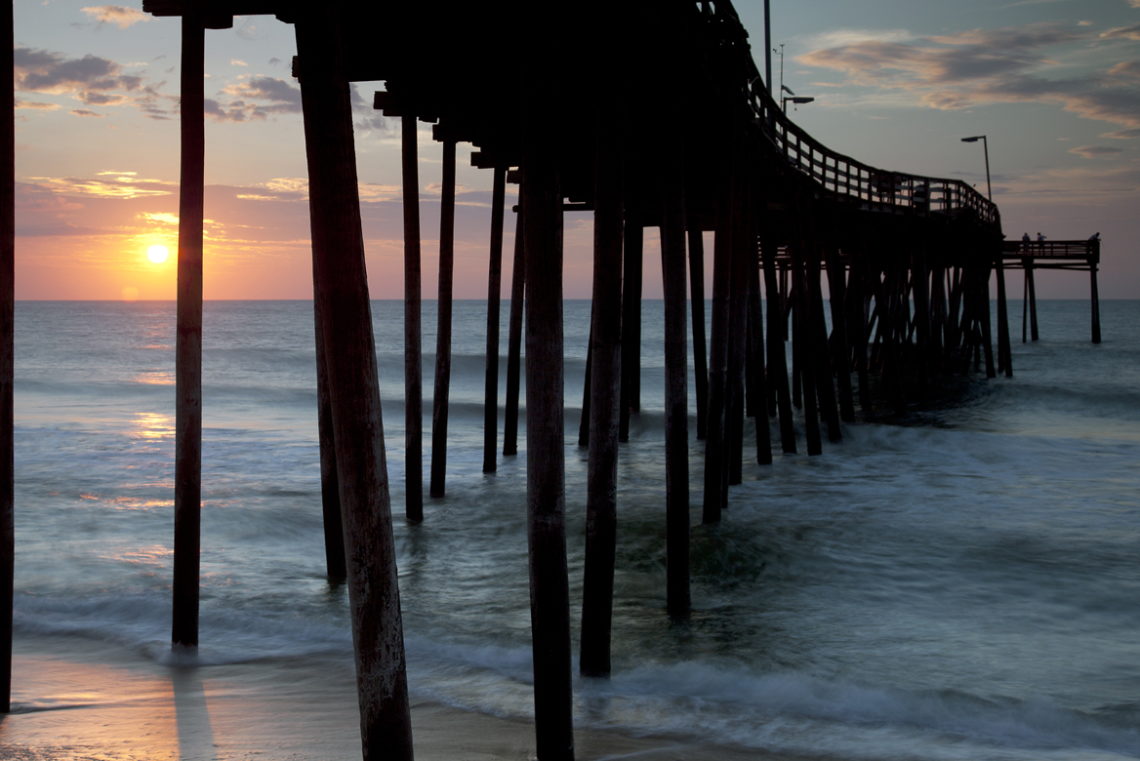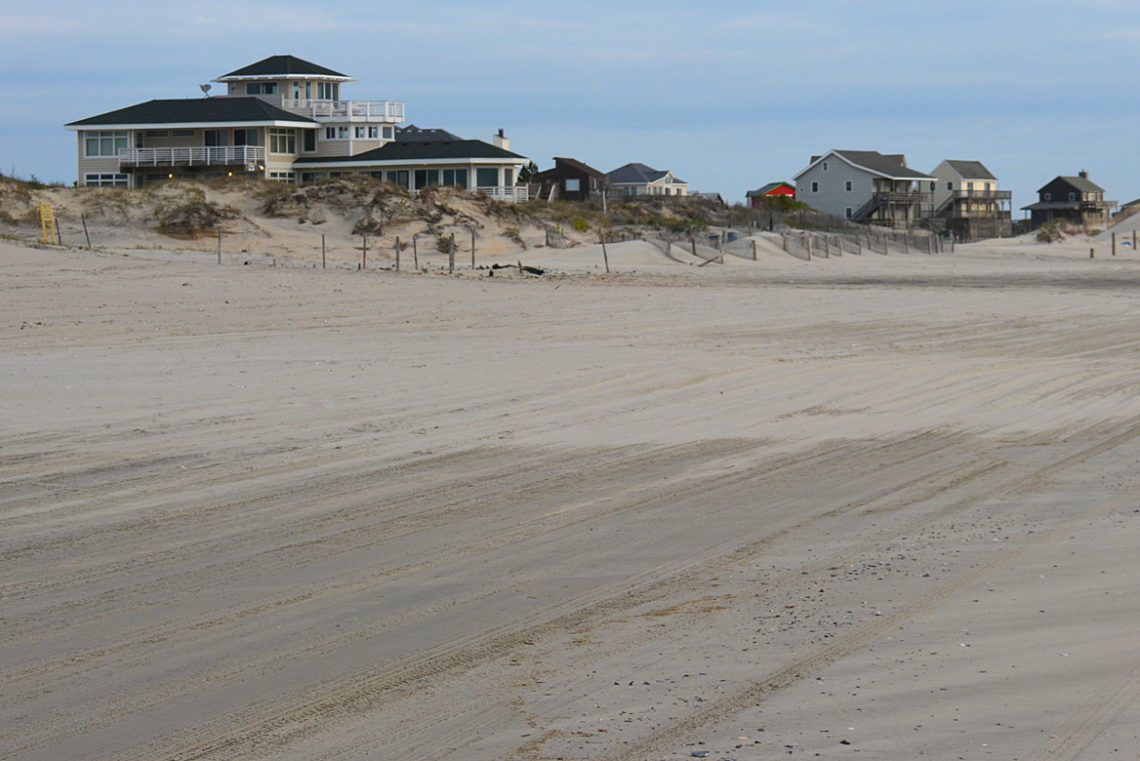
Coast Guard Auxiliarist keeps graveyard surfmen's history alive
by Coast Guard Petty Officer 1st Class L.F. Chambers
The town of Rodanthe sits precariously on the sand mound known as Hatteras, deep in the Outer Banks of North Carolina. To the west is the quiet and remote Pamlico Sound; to the east the Atlantic Ocean surges and crashes. The feverish, seething storms that thrive here have taken the lives of countless sailors, and given rise to as many legends. This is the Graveyard of the Atlantic.
Hidden among such modern beach frivolities as a water park and an ice cream shop, stand a small group of buildings that have seen well more than a hundred years of those storms. The U.S. Life Saving Service Chicamacomico Station holds its ground on seven acres and comprises eight buildings. The oldest building on the site, the 1874 station, was the first life saving station to be built and manned in North Carolina.
The wind-battered "modern" station building was erected in the early 20th century and saw Coast Guard service from 1915 to 1954. The oak steps here are worn with deep grooves marking a half century of boots pounding to the boathouse and the call to rescue.
The echoes of those who served here resonate with Coast Guard Auxiliarist James Charlet. He knows every inch of the grounds, from the 1911 cook house, where a table lays still set for morning chow, to the intricate wood-carvings that decorate the 1874 station building.
Charlet has been Chicamacomico's site manager for two years, employed by the private non-profit Chicamacomico Historical Association. His wife, Linda, serves as the operations manager here. Charlet says it's not uncommon for them to work 14-hour days. "That's if you include the discussions about this place at breakfast, dinner and all evening," Charlet says. "Sometimes Linda has to ask me to talk about something else," he says with a smile.
While his employment here is relatively recent, Charlet's experience with the site goes back much further. He has been drawn here since he first stumbled across it more than 20 years ago, on vacation from his job as a history teacher in Durham, N.C.
He was first attracted to the details of the station's architecture, but as he researched the site, he was moved by the gallantry of the surfmen that worked here on the edge of one of the most dangerous seas in the world. The nearest station, the equally isolated Pea Island Station, was six miles away.
In 1987, Charlet returned to the Outer Banks, this time to interview for a principal position at a local school. With a wistful look in his eyes he recalls standing outside the gate, looking in at the ill-kept grounds. "Something just said ‘Respect this place'," he says. "There was an ambience, a mystery here."
He was hooked.
He began reading more about the U.S. Life Saving Service, and in the process gained a fascination with the exploits of that legacy service's current torchbearer - the U.S. Coast Guard. His dark eyes shine and an infectious grin spreads under his thick gray beard as he recounts the Aug. 16, 1918 rescue of the crew of the Mirlo, a British tanker torpedoed by the Germans at the peak of the first World War.
The Chicamacomico crew, all but one named Midgett, rescued 42 British sailors at great risk to themselves among burning wreckage and oil. Members of the Coast Guard crew were each awarded Gold Life-Saving Medals, and would later receive gold medals for gallantry from Great Britain. The Coast Guard history Web site quotes the citation for the awards:
"In a heavy northeast sea that caused the lifeboat to be...tossed back upon the beach and the crew washed away from the oars time after time. Undaunted they returned to their task. After succeeding in getting their boat through the surf they were compelled to steer into a blazing inferno where the flames leaped at least 500 feet high, and were in serious danger of being burned to death if not drowned. They picked up a number of the crew of the Mirlo and towed four of the ship's boats ..."
"It was the highest decorated rescue in U.S. history," says Charlet. "It happened here."
After moving to the Outer Banks in the 1990s, Charlet took a part-time job as a site interpreter with the National Park Service, which then operated the site. He participated in a beach apparatus drill re-enactment team during that time, with a National Park Service volunteer crew using a breeches buoy and black-powder Lyle gun to reenact ship rescues on the shore. The drills, though, were suspended in 2001.
In 2006, Petty Officer 1st Class Erik Watson, executive petty officer of Station Hatteras Inlet and a surfman, called Charlet to volunteer at the site. "I didn't care if they needed the grass cut or the fence painted, I just wanted to take part in keeping our service's history alive," says Watson.
Watson met with Charlet, and "asked what it would take to start (the drills) back up again," he says. "His eyes lit up and we began a series of meetings to come up with a plan."
Watson solicited for volunteers from Station Hatteras Inlet, and Station Oregon Inlet put a crew together as well. By the summer of 2006, they were performing the drill for tourists twice a week.
The demonstrations drew hundreds of tourists that summer, and Charlet is brainstorming ideas to get more people to visit the site in 2007. "I feel like it's my mission to teach Americans about the Life Saving Service," he says. He feels that the heroics of the LSS have been unsung and hopes the Chicamacomico site will help tell their story.
"This is a special place," Charlet says before rattling off facts that people should know about the station. "It's the farthest point east in North Carolina, and only one of two sites in America with an 1874 structure, and it is the most complete life saving station in the United States," he says.
Standing on the steps of the cook house, he jokes about the never-ending repairs the site requires. "I'm a carpenter, a mechanic, a plumber, on any given day," he says. "But it's not that different from what those guys had to go through here, being so far from civilization. They had to do a little of everything too, and go out on search and rescue missions."
In the fall of 2006, Charlet took his love for the Coast Guard one step further and joined the Coast Guard Auxiliary. He serves as Cape Hatteras Flotilla 16-04's public affairs officer and once again, finds himself teaching the public about the Coast Guard.
Between his Auxiliary duties and management of the Chicamacomico Life Saving Station, Charlet admits he doesn't have a lot of free time. The long hours and constant repairs don't bother him much, though. "This is my dream job," he says as he peers out the window of the station, toward the beach where the sea rages and the wind howls.




